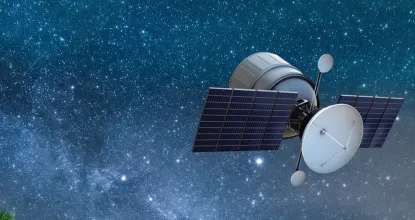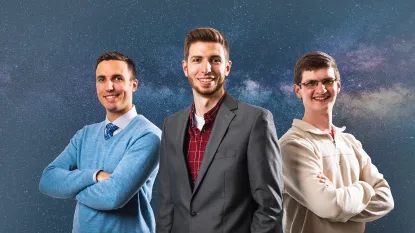
By Rebecca Tavernini '11 MA
It's been 60 years since homo sapiens first pierced Earth’s atmosphere and blasted a human-occupied object into outer space. It took a lap around the planet, then the spacecraft and its cosmonaut in separate parachutes drifted back to solid ground like heavy feathers.
In the early days of 2021, the world watched in amazement as NASA’s Perseverance aced a landing on Mars after a 300-million-mile journey, and posted a selfie upon arrival. Its accompanying helicopter soon hovered above the red planet in the first known powered flight on another world. SpaceX Ubered astronauts to the International Space Station (ISS) and returned its vehicle back to Earth to await its next hail. Then it brought four more astronauts to the ISS in April, the first time with an entirely reused rocket booster. It’s been a much-needed banner year for ethereal achievements beyond our pandemic planet.
Yet, when you gaze up at the night sky, there is much more than stars, planets and fuzzy, faraway galaxies to marvel at, and worry about. Most of the objects we send into space do not return. They stay in orbit, fall to Earth, or crash into each other, with potential, and extremely likely, disastrous consequences for us Earthlings.
There are around 34,000 orbital debris items the size of a softball or larger. Among this space junk are astronaut Ed White’s glove from the first American space-walk, Michael Collins’ camera from Gemini 10, garbage bags from the Mir Space Station, even radioactive coolant that has formed perfect spheres and is now used to calibrate radar from Earth. More significant are 1,800 cast-off rocket stages, 3,000 dead satellites and even the U.S. Vanguard 1 satellite, which has been in space longer than any other human-made object—since 1958.
There’s Elon Musk’s red Tesla eternally blasting Bowie (though scientists believe it’s beyond the orbit of Mars by now). Closer encounters were the huge, eerie, Space X Falcon 9 rocket body that sci-fi slinked over the Seattle sky in March, after it demurred to burn up on de-orbit, and the giant Chinese rocket chunk that unpredictably plummeted to our planet last month. In 1957, the North American Aerospace Defense Command started keeping the Space Object Catalog, which is now the Space Surveillance Network of the U.S. Space Force. The UN has a similar register. They estimate there are also 500,000 pieces of junk the size of a marble and over 100 million salt-grain-size specks, too small to track.
So what’s the problem?
Collisions.
But space is a big place, maybe endless. Even in our vast but limited oceans, the chance of a wayward surfer being hit by a cruise ship is slim.
Essentially most of the orbital debris is in Low Earth Orbit, 65 to 1,242 miles above earth. “LEO is now viewed as the World’s largest garbage dump,” states NASA.
“It’s as if every ship that ever sank didn’t sink,” said Austin Morris ’18 BS. “They’re just still floating out there, without sailors. Or all of the cars from crashes over the last 70 years were still driving around, without drivers.”
Even though a piece of space junk falls to Earth each day, he added, “The threat isn’t it hitting us, but hitting the satellites we depend on in our everyday lives—for financial transactions, emergency weather alerts, navigation GPS, cell phone calls, online purchases, controlling autonomous vehicles.” And things like monitoring nuclear weapons.
But never fear, Kall Morris Inc is here!
These three brilliant, young space pioneers — Adam Kall, director of technology, ’18 BS (NMU math and computer science grad with a master’s in data science), Austin Morris, director of engineering ‘18 BS (mechanical engineering technology), and Troy Morris, director of operations, ’16 BS (psychology/behavior analysis) — have combined their skills and the kind of sheer audacity of an Apollo crew to develop and launch a system to clean up space debris—and ideally, do it from Marquette.
Their vision is a series of sustainable, refuelable, orbital spacecraft to collect multiple small pieces of debris, which will eventually work together in tandem to collect large rocket bodies.
“From an academic perspective, the rocket bodies are the watershed for most of the problems, and lightning rod for most of the action. Because they’re so large,” explained Troy. “The impact ratio is 1 to 1,250 kg scale, so it could be completely obliterated into thousands of pieces that could hit other large objects, expanding exponentially. They could hit working satellites or manned spacecraft. It’s the snowball at the top of the mountain that causes the avalanche.
“It’s the Kessler Syndrome,” Kall excitedly added. “Those pieces can then collide and create even more pieces, making major collisions more frequent. Also, we are doubling the number of satellites we put up there every year, so there are more objects to impact.
“If we can remove six rocket bodies every year, that would completely halt the growth of Kessler Syndrome,” Kall said. “We expect it to cost up to $60 million to remove one. But the most expensive way to solve space debris is to do nothing right now.”
Impacts are not just theoretical. In 2009, a U.S. communications satellite and a defunct Russian weather satellite collided, breaking into thousands of pieces. The ISS had to dodge the debris cloud. A piece passed within 300 meters at a speed of 17,000 mph.
“NASA takes the threat of collisions with space debris seriously and has a long-standing set of guidelines on how to deal with each potential collision threat…with evasive action or other precautions to ensure the safety of the crew,” according to a NASA article, Space Debris and Human Spacecraft. Last year alone there were three highly concerning potential conjunctions which the ISS had to dodge.
“There’s a 50 Most Wanted List of orbital debris that we as a species should look at first,” said Kall
This is not just a pie-in-the-sky dream for the team. This is their full-time gig. They all quit their good-paying jobs last year just before COVID hit, to make this a reality. “We’re in pre-seed funding,” said Troy. “We are working toward federal grants, and through the state of Michigan we are connected with an initial capital group. Friends, family and alumni have also reached out with interest in supporting our mission. We want to do investment right, in the right order. We want to have enough progress to feel right taking people’s money.”
Thanks to NMU, they also have some pretty lofty connections and experiences. They said a benefit of COVID was being able to have fantastic virtual meetings with NASA, the European Space Agency, and other space experts. It so happens that the premier producer of electric propulsion thrusters for spacecraft is a company in Houghton, Michigan—Orbion Space Technology, with whom they’ve spent a huge amount of time.
“The first door that opened to me was right here,” said Adam, after the trio ironically got trapped in the elevator capsule of Cohodas Hall ascending to this interview. “When I was a student, I got to meet Thomas Zurbuchen, an astrophysicist who was on the NMU Board of Trustees and is now an administrator at NASA. He came up to me after I spoke at an 1899 Society dedication and said we should talk. Without that initial connection from NMU, we would not have been able to accelerate as quickly as we have or have the confidence we do.” Adam also had the benefit of a student internship at NASA’s Goddard Space Flight Center, where he was tasked with building an Artificial Intelligence program to monitor threats to NASA’s cyber network.
Troy credits the Student Leader Fellowship Program for the ability and confidence to strike out with new ideas. “You need to be uncomfortable. That’s where the best innovation comes from,” he said. “Northern never told me no, and directed me where to go. Then I just jumped in with both feet.”
Austin got early experience in terrestrial vehicles as part of the NMU Baja Team. “Figuring out how to apply the technical knowledge and leading a team, and most importantly those who don’t have a technical background, led to so much more than I would have realized,” he said, also crediting his experience at Invent@NMU. “Working on so many different projects, learning cost analysis, marketing and project management, I now know are absolutely critical in running a business.”
He also got to see Scott Kelly at NMU as part of Platform Personalities. “I’ve never encountered an astronaut who didn’t say space is the best thing ever.”
Now the Kall Morris team believe we’re entering a new space age. And being part of it is part of their DNA. “It’s not just America’s problem. The solution needs to be a collaboration with corporations and countries. It’s the democratization of space,” said Troy.
There are competitors in the orbital debris arena. But no commercial company has removed a piece of space debris.
“Even though a piece of space junk falls to Earth each day, The threat isn’t it hitting us, but hitting the satellites we depend on in our everyday lives.”
“We know we can do it faster and more cost-effective,” said Austin. “There’s a lot of debris, and we’re okay with competition. If someone else solves this, great! We have plenty of other things we want to do up there.
“Our aspirations were bigger at first: Manned stations in orbit, manned missions. My favorites are space elevators and sky hooks,” said Adam. “We wanted to do much bigger things, and tried to poke a hole into why those wouldn’t work. That led to us deciding, let’s solve space debris and then we can do these other fun things.
“When we first heard about the potential launch site at Sawyer, we couldn’t believe it,” Austin said. “Is there any way I can work in space and engineering and live in Marquette?”
Since then, the Michigan Launch Initiative site has become a controversial issue, with the new proposed, vertical launch site located at Granot Loma north of Marquette
They explained that Kall Morris Inc is not involved in the initiative. “Whether it happens or not, it makes no fundamental difference whether we proceed,” said Troy. “We could launch from wherever rockets are launching. It would just be neat to see that kind of rare spectacle right from our backyard.
Austin added that the previous night he was taking out the garbage in his Marquette driveway and happened to look up and saw the ISS passing by. The sole seven humans up there, learning all they can about long-term space exploration.
“We don’t have to innovate the entire future, just our part of it, and preserve the rest for everybody,” said Kall. “We’re like the park rangers of outer space!”

Meet the Space Pioneers
These three brilliant, young space pioneers — Adam Kall, director of technology, ’18 BS (NMU math and computer science grad with a master’s in data science), Austin Morris, director of engineering ‘18 BS (mechanical engineering technology), and Troy Morris, director of operations, ’16 BS (psychology/behavior analysis) — have combined their skills and the kind of sheer audacity of an Apollo crew to develop and launch a system to clean up space debris—and ideally, do it from Marquette.
Pictured from left are Troy Morris, Austin Morris and Adam Kall
Exclusive Digital Content:
'Northern Now' on Artificial Intelligence and the Job Market
Learn more about Kall Morris from Adam Kall in this special Northern Now session on artificial intelligence and the job market. Also featured in this segment are alumna Anna Martin ’20 BS, and professors Jeff Horn and J.D. Phillips.
Northern Now, is a monthly digital event series for alumni and friends hosted by the NMU Alumni Association.